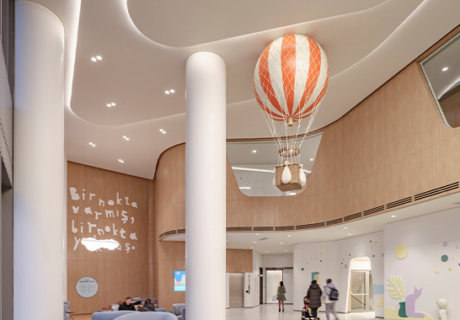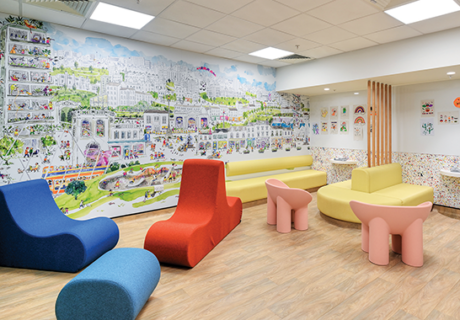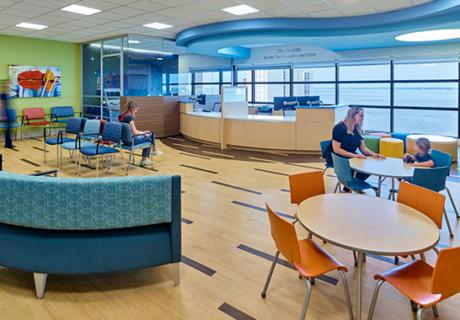Uplifting Design At St. Christopher’s Hospital For Children
Leaders of St. Christopher’s Hospital for Children in Philadelphia wanted to set the tone for a new four-story, 135,000-square-foot critical care tower by creating a lobby that was welcoming and playful. But they weren’t looking for stereotypical cartoon characters or a primary color palette.
“One of the issues in a lot of pediatric hospitals is that the theming is done in a cartoonish way that relates to children ages 8 and below,” says Saul Jabbawy, director of design at EwingCole (Philadelphia). “We wanted something that would be inspiring and thematically interesting to people of all ages and could [still] relate to children.”
Toying with the idea of combining child’s play with special locations in the region, the design team developed features for the space such as large-scale graphics of local settings complemented by origami shapes cast into the flooring to serve as a wayfinding.
The biggest statement in the 6,800-square-foot lobby is a mosaic wall that depicts a scene of hot air balloons. “It’s something that’s hopeful, and it’s very uplifting to whomever sees it,” Jabbawy says.
But the fun didn’t stop there. The team began exploring how to bring the balloon image to life, considering using glass tiles to amplify its impact. “But at the end of the day, that’s not very interesting,” Jabbawy says. Instead, building on the theme of play, the team turned to a small toy familiar to all: the marble. “On a visual level, they provide a sense of depth and light that no other material would provide,” Jabbawy says.
EwingCole enlisted the help of tile company Artaic (Boston) to pixelate the hot air balloon image, creating a “paint-by-number” map that outlined the placement of nearly 200,000 marbles in 16 different colors.
Millwork subcontractor Artisan Display (Red Hill, Pa.) then constructed the mosaic by dividing the image into 33 4-foot-wide MDF panels with indentations to hold the marbles. An Artisan employee then used the image map to coordinate the location of each marble to its corresponding position on the panel, gluing each marble into place one at a time.
Steel-reinforced studs covered in a heavy layer of plywood were constructed in the lobby to support the weight of the panels, each nearly 200 pounds. “We brought them to the site and hung them like you would hang a millwork panel onto the plywood,” Jabbawy says. Unframed glass plates are mounted in front of the marble panels and are sealed at the top and bottom to protect the mosaic and keep it clean.
With such a colorful statement on one side of the lobby, the design team then turned its eye to multiple columns on the opposite side of the space, which felt institutional in comparison. To solve that issue, designers covered two sides of the columns with colorful bubble-shaped cutouts, while the other sides are backlit with a fuchsia color that extends from the columns across the ceiling to create a series of arches.
“A lot of children’s hospitals go toward masculine colors, like blues, greens, and yellows, and we thought, ‘Why can’t we use fuchsia as a primary space-forming element?’” Jabbawy says. “It’s a great color.” The arches align with decorative fins on the ceiling that are also backlit in a complementary blue color. “The whole idea was not treating the ceiling as one continuous horizontal plane but creating depth,” he says.









